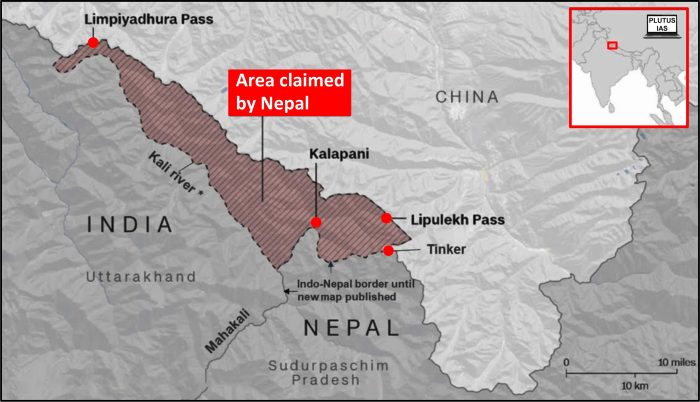Syllabus:
GS2: India and its neighborhood- relations.
Context:
India recently dismissed Nepal’s objection to India-China trade via Lipulekh Pass, saying Nepal’s claims lack a historical basis.
More on the News
- India and China agreed to resume border trade through Lipulekh Pass, Shipki La and Nathu La during a meeting between their foreign ministers.
- Nepal asserted its claim over the Lipulekh region and expressed concern over the India-China agreement to open a trade route through it.
India-Nepal Border Dispute
- The territorial dispute between India and Nepal over the Kalapani region originates from the Treaty of Sugauli, signed at the end of the Anglo-Nepalese War in 1816.
- Article 5 of the treaty took away the jurisdiction of Nepal’s rulers over the land to the east of the Kali River.
- However, the exact source of the Kali River has been disputed, as different historical maps have shown varying origins for the river.
- Early British India maps (1819, 1821, 1827, and 1856) depicted the Kali River originating from Limpiyadhura.
- Later maps, particularly from 1879 and 1920-21, showed a different river, Kuti Yangti, as the Kali. This inconsistency has fueled the ongoing dispute.
- Following the 1950 Peace and Friendship Treaty, India and Nepal established and encouraged a clearly defined and mutually accepted open border.
- The latest dispute erupted in the aftermath of the abrogation of Article 370 and the creation of new Union Territories of Jammu and Kashmir (J&K) and Ladakh.
- Following this, India published a new political map in November 2019, which showed the region of Kalapani as part of the Indian territory.
- This prompted Nepal to introduce a map that claimed the Kalapani-Lipulekh-Limpiyadhura region of Pithoragarh as part of its territory.
- Further, a constitution amendment Bill was passed by Nepal’s parliament to legitimise the alteration to the country’s map.
Challenges in Border Administration
- Territorial Dispute: The Kalapani border has yet to be properly demarcated, especially the so-called ‘no-man’s land’ in the area.
- External Influences: Increasing Chinese influence in Nepal and potential interference from other external actors can complicate border dispute resolution and cooperation.
- Ineffective Joint Mechanisms: Joint mechanisms like the 1981 Border Inspection and 1997 Border Management Committees were set up by India and Nepal but key boundary issues remain unresolved.
Challenges in Border Administration
- Territorial Dispute: The Kalapani border has yet to be properly demarcated, especially the so-called ‘no-man’s land’ in the area.
- External Influences: Increasing Chinese influence in Nepal and potential interference from other external actors can complicate border dispute resolution and cooperation.
- Ineffective Joint Mechanisms: Joint mechanisms like the 1981 Border Inspection and 1997 Border Management Committees were set up by India and Nepal but key boundary issues remain unresolved.
Way Forward
- Revive the Joint Technical Level Boundary Committee: Reconstitute a dedicated technical committee of experts from both countries to resolve the remaining 3% of boundary issues systematically.
- Border demarcation and Management: A clear and unambiguous demarcation of the border, based on existing treaties and agreements, is fundamental.
- Legal and Institutional Framework: Developing a clear legal framework for border governance can provide a solid foundation for managing the border issues and resolving disputes.
Sources:
https://www.orfonline.org/research/india-and-nepals-kalapani-border-dispute-an-explainer-65354

